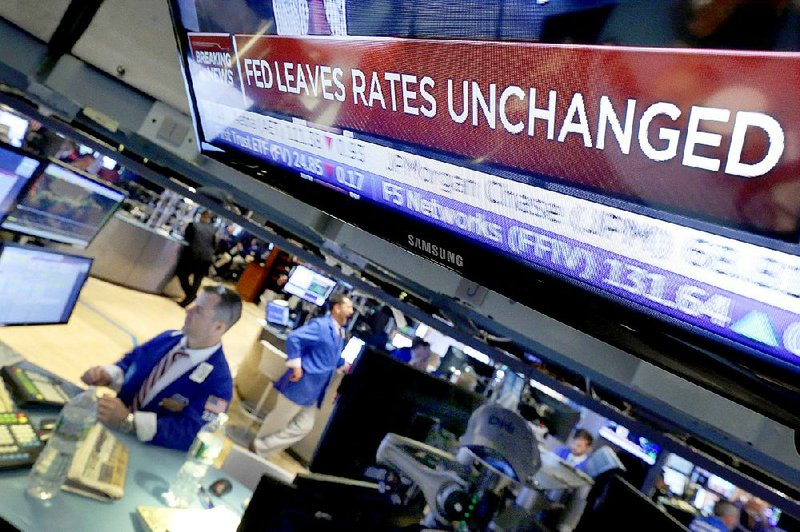WASHINGTON -- The Federal Reserve appears on track to raise interest rates later this year but signaled Wednesday that it wants to see further economic gains and higher inflation before doing so.
A statement from the Fed after its latest policy meeting provided no timetable. Many analysts foresee the first increase in September, although Fed Chairman Janet Yellen has stressed that any increase will be driven by the latest economic data.
The statement noted that the job market, housing and consumer spending all have improved. The Fed still expects inflation to rise gradually toward its 2 percent target.
Wednesday's statement made only slight changes in the wording of the previous statement in June. The few modifications suggested a healthier economy.
Describing the job market, the Fed for the first time pointed to "solid" job gains and declining unemployment. The unemployment rate has reached a seven-year low of 5.3 percent.
In addition, the Fed said it needs to see only "some further" improvement in hiring, rather than the "further" improvement it said last time -- a hint that the job market is nearing full health.
"The committee is keeping the door open for rate hikes later this year, not necessarily opening it further or closing it," said Michael Gapen, chief U.S. economist for Barclays PLC in New York and former Fed board section chief in charge of monetary and financial markets analysis. "Labor markets have improved further, and they need to see a little more improvement to be ready to go, so that says September or December is in play."
Michael Hanson, an economist at Bank of America Merrill Lynch, said the Fed's more upbeat language about the job market suggests that policymakers are nearing the point where they will raise rates. He expects that to occur in September.
"They haven't made up their minds, but ... we're getting that much closer to satisfying their criteria" for a rate increase, Hanson said.
Yellen has stressed that when the Fed begins to raise rates, it will do so gradually. The idea is to avoid weakening an economy that's benefiting from low borrowing rates resulting from the Fed's policies. She has suggested that raising rates in small increments, followed by pauses, will let the Fed assess the effects of slightly higher borrowing costs.
The Fed has kept its key short-term rate at a record low near zero since 2008. Once it raises it, other rates -- for mortgages, auto loans and corporate borrowing -- could rise, too.
"In my mind, the Fed is very comfortable with a slow, deliberate pace," said Brian Bethune, an economics professor at Tufts University in Boston. "The Fed doesn't want to upset the apple cart with any type of market shock that could cause further problems in the global economy, whether that is in China or in Europe."
The statement was approved on a 10-0 vote, marking the fifth straight time it has been unanimous.
Yellen has left little doubt that the Fed is preparing to raise short-term rates by year's end from the near-zero lows it set at the depths of the 2008 financial crisis. Earlier this month, she told Congress that she thought the economy not only can tolerate but also needs higher rates.
The economy still faces many threats, from subpar U.S. manufacturing and business investment to troubles in Europe and Asia, which have roiled financial markets. Inflation also remains below the Fed's target rate.
A few gauges of the job market remain less than healthy. Pay growth remains generally sluggish, for example, and many people are working part time because they can't find full-time jobs.
The Center for Popular Democracy has criticized the Fed for not focusing enough on wage improvements as a factor in deciding when to raise rates.
Although the September meeting, when Yellen is set to hold a news conference, is seen as the most likely time for a rate increase, some analysts think the Fed might wait until December.
The Federal Open Market Committee is next scheduled to gather Sept. 16-17, with additional meetings this year set for October and December.
Traders are pricing in a 40 percent probability that the Fed raises rates at the September meeting.
During Yellen's testimony to Congress this month, some Democrats urged her to consider delaying a rate increase given that inflation remains below the Fed's 2 percent target. The Fed typically has raised rates when it perceives a need to prevent inflation from getting out of control.
Part of the slowdown in inflation, though, reflects a plunge in oil prices over the past year, which will reverse itself once energy prices rebound.
The Fed is closer to achieving its other main goal: maximizing employment. The unemployment rate is at a seven-year low, and over the past three months, U.S. hiring has averaged a robust 221,000 a month.
Information for this article was contributed by Martin Crutsinger and Christopher S. Rugaber of The Associated Press; by Christopher Condon and Jeff Kearns of Bloomberg News; and by Jim Puzzanghera of the Los Angeles Times.
Business on 07/30/2015
